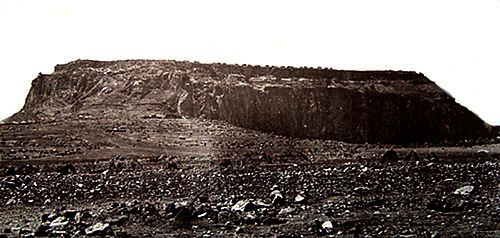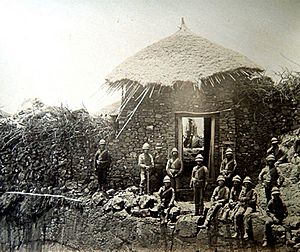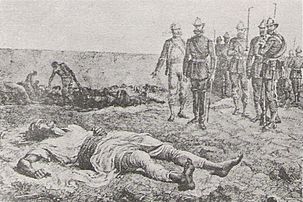Battle of Magdala facts for kids
Quick facts for kids Battle of Magdala |
|||||||
|---|---|---|---|---|---|---|---|
| Part of the 1868 Expedition to Abyssinia | |||||||
 |
|||||||
|
|||||||
| Belligerents | |||||||
|
Supported by: Ethiopian rebels |
|||||||
| Commanders and leaders | |||||||
| Robert Napier | Tewodros II | ||||||
| Strength | |||||||
| 13,000 | ~4,000 | ||||||
| Casualties and losses | |||||||
|
|
||||||
The Battle of Magdala was a big fight that happened in April 1868. It was the final part of a British journey to Abyssinia (which is now Ethiopia). This battle took place at a strong mountain fortress called Magdala. It was about 390 miles (630 km) from the Red Sea coast.
The British forces were led by General Robert Napier. The Abyssinian (Ethiopian) forces were led by their ruler, Emperor Tewodros II.
The reason for the British expedition started in 1866. Emperor Tewodros II had sent a letter to Queen Victoria of Britain. He asked for weapons and military experts. But his letter was not answered. Because of this, Tewodros became angry. He arrested a group of missionaries and a British official named Captain Cameron. They were later released, but Tewodros changed his mind. He sent his soldiers to bring them back to the fortress. They were then imprisoned again.
The British won the Battle of Magdala. Emperor Tewodros II died as his fortress was captured.
Contents
How the British Prepared for Battle
The first British soldiers arrived at Annesley Bay on December 4, 1867. But they couldn't get off their ships until December 7. This was because the land was very messy. Thousands of mules had been sent from Egypt and other places. But there was no food or water ready for them. So, the new troops had to find supplies first. They set up a main camp at Zula.
The British soldiers wore new khaki drill jackets. They also had white cloth-covered helmets called 'Topi'. The year before, they had received new Snider-Enfield rifles. These rifles were much faster. Soldiers could fire ten rounds per minute instead of three. This greatly increased their firepower.
Lord Napier arrived in early January 1868. The journey to Magdala began in February from a camp at Senafe. It took two months to reach the fortress. The British forces traveled through very rough land. They went through mountains and across high plains. Emperor Tewodros had built a road through the Zhitta Ravine. This road helped him move his heavy cannons to Magdala. The British used this same road to reach their target.
The British force had about 12,000 British and Indian soldiers. They also had Royal Artillery and Royal Engineers.
British Troops: These included the 3rd Dragoon Guards, the 4th Regiment of Foot, and the 33rd Regiment of Foot. Six companies from the 45th Nottinghamshire Regiment were also there. A Royal Navy rocket battery joined them. An artillery battery with cannons carried by elephants also joined the group.
Indian Troops: These included the 10th and 12th Regiments of Bengal Cavalry. The 3rd Regiment of Bombay Light Cavalry was also present. Many Indian infantry regiments were part of the force. These included the 21st and 23rd Punjab Regiments. Other units were the 2nd, 3rd, 10th, 21st, 25th, and 27th Bombay Native Infantry. Indian artillery and engineer groups also took part.
It is hard to know exactly how many Abyssinian soldiers there were. British reports suggest they had some cannons. They also had several thousand foot soldiers. Most of these soldiers did not have firearms.
The Battle Begins
Before attacking Magdala, the British had to get past a plateau called Arogye. This was the only way to reach Magdala. It looked very hard to attack. The British could see thousands of armed Abyssinians. They were camped around the hillsides. They also had up to 30 cannons.
The British did not expect the Abyssinian warriors to leave their defenses. So, they were not fully ready for an attack. But Emperor Tewodros ordered his soldiers to charge. Thousands of them attacked, mostly armed with spears. The 4th Regiment of Foot quickly got ready. They fired many shots into the attacking soldiers. When two Indian regiments joined in, the firing became even stronger.
Even with heavy losses, the Abyssinian soldiers kept attacking. They lost over 500 men and many more were wounded. Most of these losses happened very close to the British lines. During the fight, a group from the 33rd Regiment captured some Abyssinian cannons. The remaining Abyssinian soldiers then went back to Magdala.
About 600 to 700 British and Indian soldiers were in this first fight. One of the missionaries watching said the new Snider rifles were key. They could fire six shots a minute, which was very powerful.
Lord Napier sent a message to London about the battle. He said they had approached Magdala. Tewodros had fired seven cannons at them. Then, 3,500 of his soldiers made a brave attack. But they were pushed back with heavy losses. The British had only twenty wounded soldiers. Two of these wounded soldiers later died from their injuries.
Taking the Fortress
The next day, the British moved toward Magdala. A man named Clements Markham later wrote about a strange thing that happened. A dark brown circle appeared around the sun. Emperor Tewodros saw it and said it was a sign of bloodshed.
Tewodros II sent two of the prisoners to offer a deal. Napier said all prisoners must be freed. He also demanded that Tewodros surrender completely. Tewodros refused to surrender fully. But he did release the European prisoners. Sadly, the native prisoners were not released safely.
The British continued their attack on the fortress. They started by firing mortars, rockets, and artillery. Then, infantry soldiers fired their guns. This gave cover to the Royal Engineers. Their job was to blow up the fortress gates.
The path to the main gate was very steep and rocky. On one side was a cliff, and on the other, a sheer rock face. The main gate was called the Koket-Bir. It had thick wooden doors within a 15-foot-long (4.6 m) stone archway. Thorny hedges protected each side of the gate. After this gate, there was another uphill path to a second gate. This led to the final plateau, or amba.
When they reached the first gate, the attack stopped. The engineers had forgotten their explosives and ladders. They had to go back for them. General Staveley was unhappy about the delay. He ordered the 33rd Regiment to keep attacking.
Some officers and men from the 33rd Regiment, along with an engineer, went ahead. They climbed the cliff face. They found their way blocked by a thorny hedge over a wall. A very tall soldier, Private James Bergin, used his bayonet to cut a hole. Drummer Michael Magner climbed onto his shoulders and through the gap. He then pulled Private Bergin up. Other soldiers helped from below.
As more soldiers came through, they fired their guns. They advanced with their bayonets ready. The defenders pulled back through the second gate. The British rushed the Koket-Bir before it could be fully closed. They then took the second gate. This broke through to the main plateau. Ensign Wynter climbed onto the second gate. He put up the 33rd Regiment's flag to show the plateau was taken. Private Bergin and Drummer Magner later received the Victoria Cross for their bravery.
Emperor Tewodros II was found dead inside the second gate. When his death was announced, all fighting stopped. His body was buried in the church by priests. Soldiers from the 33rd Regiment guarded the church. However, according to Henry M. Stanley, the church was looted. Many gold, silver, and brass crosses were taken. Rare religious items called tabots were also stolen.
After the Battle
Magdala used to belong to the Muslim Galla (now Oromo) tribes. But Tewodros had taken it back from them. Two Galla queens, Werkait and Mostiat, had helped the British. They both wanted control of the fortress as a reward. Napier wanted to give Magdala to the Christian ruler of Lasta, Wagshum Gobeze. He thought Gobeze could stop the Gallas and protect Christian refugees. But Gobeze was more interested in Tewodros' cannons. The two Galla queens also couldn't agree. So, Napier decided to destroy the fortress.
For winning the campaign, General Napier was honored by Queen Victoria. He became Baron Napier of Magdala. Soldiers who fought in the campaign received the Abyssinian War Medal.
After the British left, there was fighting in Ethiopia. Many people wanted to become the new emperor. This lasted from 1868 to 1872. Finally, Dajamach Kassai of Tigray became powerful. He had received British weapons from the Magdala expedition. In 1871, he won the Battle of Assam. He defeated his rival, Wagshum Gobeze, even with fewer troops. Kassai was crowned Emperor of Ethiopia. He took the name Yohannes IV.
Two people who were affected by these events were Ethiopian Prince Alemayehu and British soldier John Kirkham. Tewodros had asked his wife to put his son, Alemayehu, under British protection. He feared his son's life would be in danger. So, Alemayehu was taken to London. He met Queen Victoria, who liked the young boy. Alemayehu later studied in England. But he became lonely and sad. In 1879, he died at age 19 from illness. He was buried near St George's Chapel, Windsor Castle. Queen Victoria placed a plaque there in his memory.
John Kirkham stayed in Ethiopia. He became an advisor to Emperor Yohannes IV. Kirkham helped train Ethiopian troops to fight like Western armies. His troops played a big part in defeating Yohannes' rival, Wagshum Gobeze. Kirkham died in prison in 1876.
Looting and Returns
On April 19, the British blew up the fortress. They also burned the city. Then, Napier began the march back. Many elephants and mules were needed to carry the stolen goods across a river. A big auction of the loot was held. The money was given to the troops. No list was made of who bought what.
Many stolen objects, cultural items, and artworks ended up in British collections. Most books and writings went to the British Museum or Bodleian Library. Some went to the Royal Library at Windsor Castle. Other items went to museums like the Victoria and Albert Museum.
These items helped people in Europe learn more about Ethiopia's history and culture. This led to the study of Ethiopian Studies. It also helped research the ancient Kingdom of Aksum.
Over time, some of the stolen treasures have been returned to Ethiopia. Since 1999, a group called AFROMET has been working to get more items back.
Here are some items that have been returned:
- A copy of the Kebra Nagast and a picture of Jesus were returned to Emperor Yohannes IV in the 1870s.
- One of Tewodros' two crowns was returned in 1924. But a more valuable gold crown stayed in the Victoria and Albert Museum.
- In the 1960s, Queen Elizabeth II returned Tewodros' royal cap and seal to Emperor Haile Selassie.
- In 2019, a lock of Tewodros' hair was returned. It had been taken after his death.
- In 2021, many items were bought by a British group to return them to Ethiopia. These included a Coptic bible, crosses, a shield, and a crown. This was called "the single most important heritage return in Ethiopia's history."
The Ethiopian government has also asked for Prince Alemayehu's remains to be returned. He is buried at Windsor Castle.
See also
- Sebastopol (cannon)











